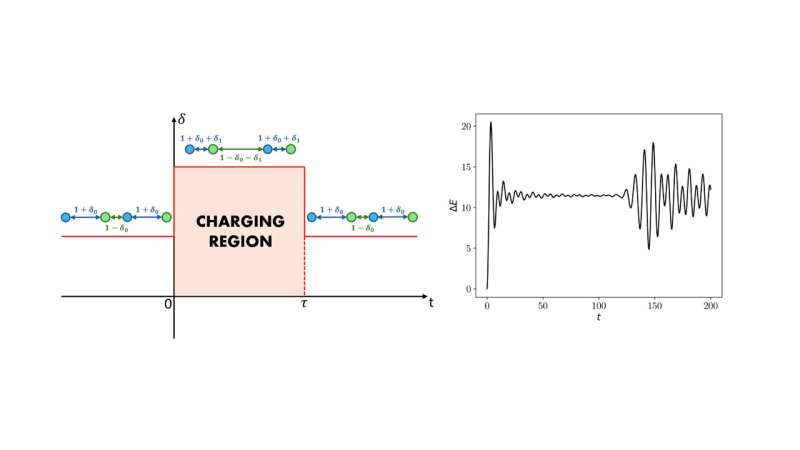
Over the past few years, some researchers have been working on alternative energy storage systems that leverage the principles of quantum mechanics. These systems, known as quantum batteries, could be more efficient and compact than conventional battery technologies, while also achieving faster charging times.
In a recent paper published in Physical Review Letters, a research group at University of Genova introduced a new spin quantum battery, a battery that leverages the spin degrees of freedom of particles to store and release energy. This battery is charged in a unique and advantageous way, without the need for an external field.
“Quantum many-body theory and non-equilibrium physics are traditional topics in the quantum condensed matter theory group led by Maura Sassetti at University of Genova,” Dario Ferraro, senior author of the paper, told Phys.org.
“In this framework, my officemate Niccolò Traverso Ziani focuses on the study of analytically solvable quantum spin chains, while I study quantum batteries—miniaturized devices able to store energy exploiting quantum mechanical principles. We thought that the master’s thesis of Riccardo Grazi could be a good excuse to combine our research interests.”
Ferraro and his colleagues at University of Genova were ultimately able to extend their investigation of spin quantum batteries to a regime with a very large number of elements. This is a goal that had so far been impossible to achieve using common approaches for designing spin quantum batteries.
“Our quantum battery can be seen as the intercalation of two collections of ½-spins, the simplest possible quantum systems,” explained Ferraro. “By properly changing the interaction between the elements of the two chains, for example by shifting one with respect to the other, it becomes possible to trap energy into the quantum battery in a stable way.”
The protocol developed by Ferraro and his colleagues has various advantages over existing spin quantum battery designs. Most notably, it allows their battery to be charged via a new mechanism that does not rely on the presence of an external field.
“The main results of our work include the exploration of an alternative charging protocol for spin quantum batteries, which is based on time-dependent modulation of one of the system’s internal parameters, and the possibility to study this protocol on the limit of a very large number of elements composing the device,” said Ferraro.
“We think that this will open new and interesting perspectives in the study of quantum batteries, including the possibility to realize them using systems such as neutral atoms, which are currently among the leading platforms in the race towards large-scale quantum computers.”
Ferraro and their colleagues evaluated the new spin quantum battery design and charging protocol in a series of initial tests. Their results were highly promising and highlighted the robustness of their proposed charging method, which does not require great accuracy to enable the manipulation of the battery in real-time.
In the future, this study could pave the way for the development of new highly performing and stable solid-state quantum batteries. Meanwhile, Ferraro and his colleagues plan to continue working on their protocol for charging spin quantum batteries, while also exploring its susceptibility to other environmental factors.
“We are currently exploring how factors like temperature and long-range interactions affect the charging process of a large class of quantum batteries, which includes the Ising model already briefly discussed at the end of our paper,” added Ferraro. “Our primary goal is to identify a general framework, applicable to a wide range of systems, to determine if they are suitable candidates for implementation as quantum batteries
